NORTH WALES COAST
RAILWAY: NOTICE BOARD
Rheilffordd arfordir gogledd Cymru: Hysbysfwrdd
11 April 2011
 Last issue
Last issue Archive
Archive Contributions and comments are encouraged: see the Contributions Page
This site is dedicated to all our regular contributors and supporters, and especially the rail staff of North Wales.
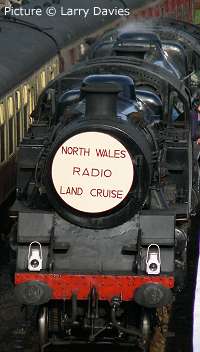
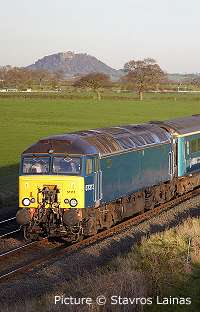
Forthcoming events
April 2011
Thursday 14 April Llandudno and Conwy Valley Railway Society
"We built the Railway" An interesting talk by Dafydd Thomas and a colleague on the engineering
tasks that were required to complete the Welsh Highland Railway through the
Aberglaslyn Pass and into Porthmadog.
Monday 18 April RCTS Chester Geoff Morris: ANOTHER AUSTRALIAN ADVENTURE. A digital presentation of Geoff’s 2010 visit to Australia featuring main line & preserved steam in Victoria, New South Wales & Queensland plus views of the modern scene and the odd kangaroo!
Thursday 28 April Merseyside Railway History Group Richard Kells: Quiz and informal evening
May 2011
Thursday 12 May Llandudno and Conwy Valley Railway Society
A presentation by Paul Lewin, General Manager, FR/WHR on the current
operations of these two fascinating railways.
Thursday 12 May Steam at Chester 'The Cathedrals Explorer' Steam Dreams Oxenholme - Carmarthen via Chester - Shrewsbury - Llandrindod.
Friday 13 May Excursion 'The North Wales Scotsman' Compass Tours Holyhead, Llanfairpwll, Bangor, Llandudno Junction, Colwyn Bay, Rhyl, Flint & Chester to Dundee via the Forth & Tay Bridges.
June 2011
Sunday 19 June Steam on the Coast: Northern Belle Father's Day Special. Crewe-Holyhead and return with 46201 Princess Elizabeth.
See the Calendar page for more details and later dates.
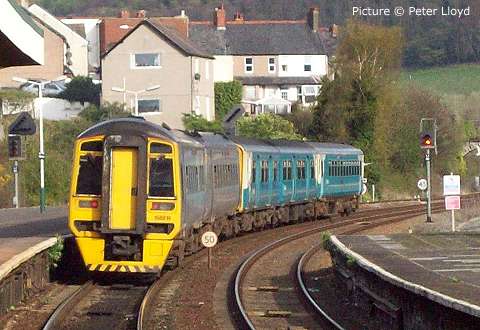
Three types of rolling stock in one train, as 1V63 the 16.39 Holyhead to Cardiff leaves Llandudno Junction on 9 April at 17:25, formed of 153 362, 150 236 and 158 819. Picture by Peter Lloyd.
RCTS News - by Richard Neale
The Railway Correspondence and Travel Society meets for the final time this season at the Town Crier opposite Chester railway station on Monday 18th April at 7.30 p.m.
Our speaker is Chester resident [and website contributor] Geoff Morris with his digital presentation entitled 'Another Australian Adventure.’ This features Geoff’s return visit to Australia last year featuring main line and preserved steam in Victoria, New South Wales and Queensland plus views of the modern scene and the occasional kangaroo.
Visitors are more than welcome to attend this meeting but with a £2 voluntary donation. Such donations enable the Society to continue its regularity of such meetings.
RCTS members and other local rail society groups are asked to note that as from this September the local RCTS branch will only be arranging Chester monthly meetings and will no longer be holding any meetings at Port Sunlight.
Freight scenes
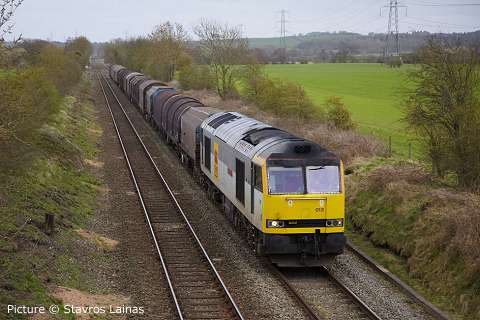
60 013 Robert Boyle (above) passes Haughton, just south of Gobowen, on the Llanwern to Dee Marsh steel coil train, running an hour late in dwindling light (Stavros Lainas)
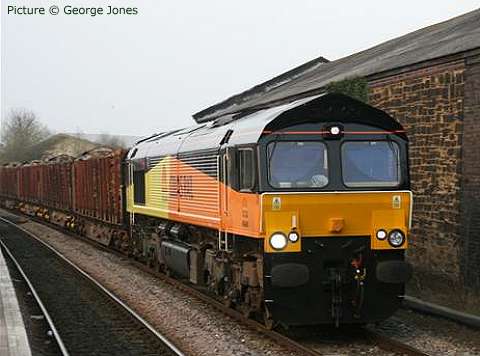
28 March, first of the light evenings and a chance for George Jones to see 'the logs' passing Wrexham General en route for Chirk. However it ran a little late and only just got through at 19:00 with the Holyhead-bound pair of 158 Units waiting the road to Chester. 66 845 was on the job hauling 21 wagons with the sun going down in the west after a delightful blue sky day.
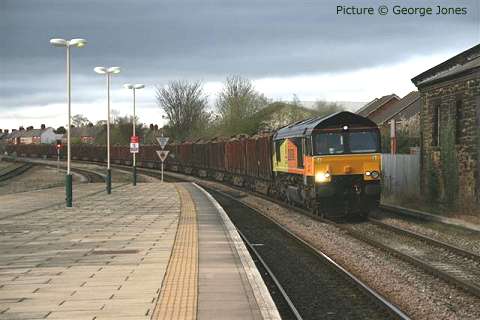
18:55 on 5 April, and 66 845 is on duty again with the log train to Chirk, passing Wrexham station (George Jones).
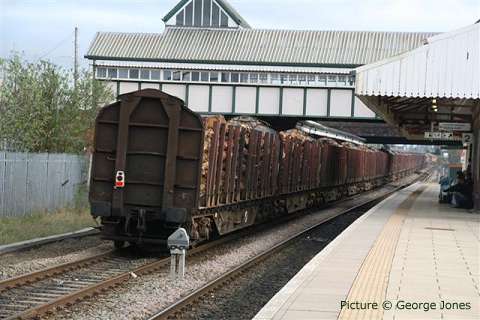
In the second picture the last of the wagons is approaching the end of platform 1, whilst the engine is up around the Croes Newydd crossing (George Jones). The train has been reported running on Saturdays passing Chester around 16:00, as well as weekday evenings.
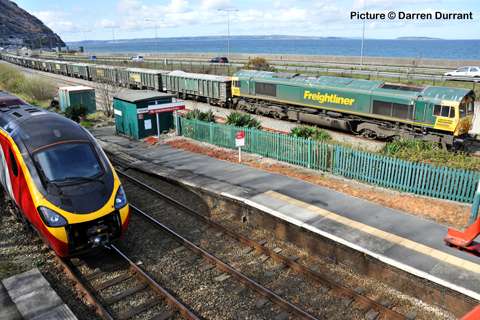
The Penmaenmawr - Gude Bridge stone train ran on Saturday 2 April, enabling Darren Durrant to get this view of 66 620 and its train being loaded as the Holyhead-bound Pendolino passed Penmaenmawr station. It appears that the stone train now runs on alternate days, on a full seven-day cycle, so it will be seen Saturday one week and Sunday the next.
.
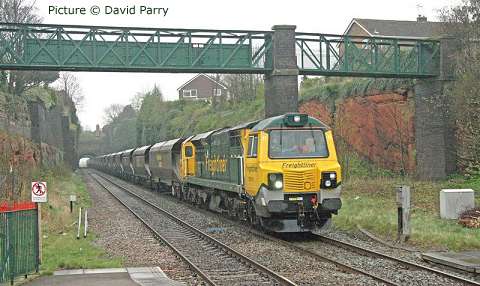
No. 70 011 approaches Frodsham station with the morning inbound empty wagons for the Ellesmere Port - Fiddlers Ferry coal train on a drizzly 7 April (David Parry).
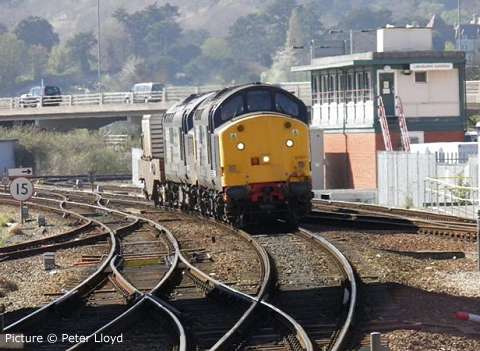
37 604 and 37 218 with 6K41 Valley - Crewe flask passing Llandudno Junction signal box at 14.57 on 8 April (Peter Lloyd).
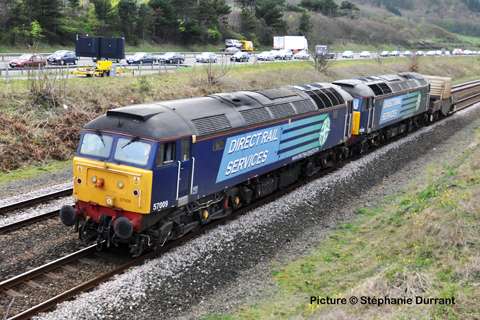
11 April's flask train featured 57 009 and 57 008, seen at Llanddulas (Stéphanie Durrant)
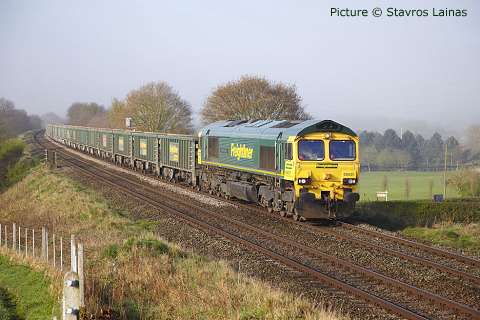
On 7 April a trial freight ran from the sand quarry at Middleton Towers in East Anglia to Ellesmere Port, carrying sand for the Quinn Glass factory. Stavros Lainas photographed the empty wagons returning to Crewe on 8 April behind 66 601 The Hope Valley, passing Daresbury.
Miscellaneous notes
Following the recent article about the lack of North Wales members on the Wales Assembly's Public Transport Users Committee, we hear that at least one person from North Wales was interviewed for the role. The person in question, from Llandudno, does not have a car and uses public transport a great deal, but was turned down, on the grounds that his 'knowledge of diversity and equalities was not of the required standard.'
Regarding the complaints by Express Motors about unfair competition from the Conwy Valley trains, Leslie Fletcher writes 'The X1 service might have more passengers were the operator to see its role as complementing the Conwy Valley train service rather than competing with it. In the October 2010 X1 timetable, buses arrive in Dolwyddelan from Llandudno at 11.10, 14.20 and 17.10; trains arrive at 11.13, 14.12 and 17.13. The situation going down the valley is not quite so grotesque but were Express Motors to run its whole timetable 30 minutes earlier then the service to the public would be significantly enhanced.'
On the subject of freight traffic, we gather that the refuse tip at Llanddulas quarry is getting close to being full, and there is a plan to run 'bin liner' trains of domestic refuse from Llandudno Junction to some remote disposal location. Does anyone know more?
A strange result of the late-lamented Wrexham & Shropshire operation is that the Department for Transport mandarins have decided to fine Chiltern Railways half a million pounds. Among other crimes, we read that 'It came to light that Chiltern [made] unapproved changes to the timetable, which were actually to accommodate services offered by the open access operator, Wrexham, Shropshire and Marylebone Railway Company Limited (WSMR). This contravention of Chiltern’s contractual obligations was only identified from a WSMR press release and subsequent investigation by the Department’s franchise management
team. The effect on passengers may be considered minor but, in the context of favouring WSMR commercial improvements over Chiltern Railways' own services, the effect on the Department could have been
significant.' Read the full horror story in this PDF file.
Spring Gala at Llangollen
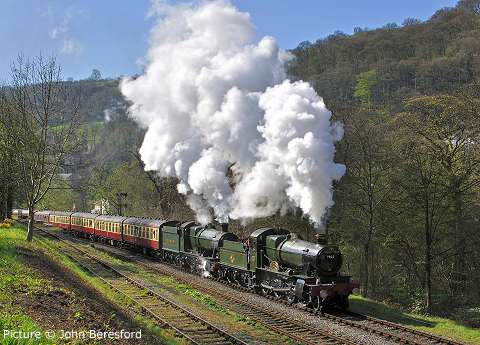
The Llangollen Railway steam gala on 8-10 April was a huge success, with more families attending than enthusiasts. Passenger numbers were excellent during all three days, and of course the weather played a big part. 7822 Foxcote Manor leads 2-8-0 3802 out of Llangollen in the morning of 8 April, before the warm sunny weather reduced the steam effects; of course, the sunshine will have attracted people to travel on the trains and helped the railway's fund-raising efforts, which after all is the main point of the gala (John Beresford).
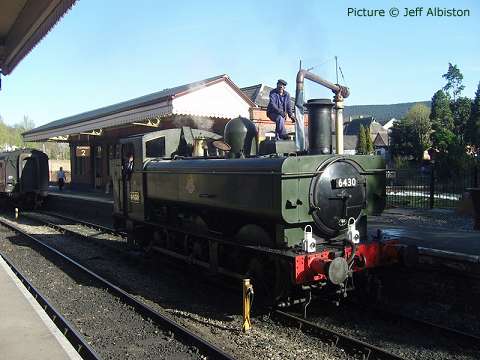
GWR Pannier 6430
takes water on platform 2, Llangollen on 8 April (Jeff Albiston).
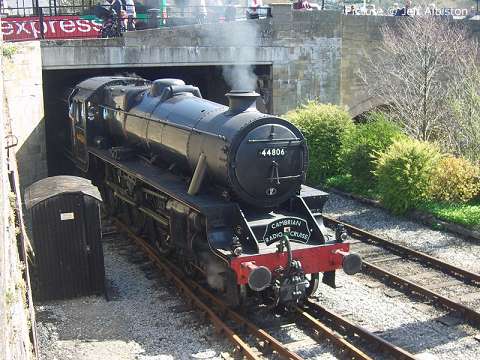
LMS Black 5 44806
takes a rest in between duties in the headshunt at Llangollen on 8
April (Jeff Albiston).
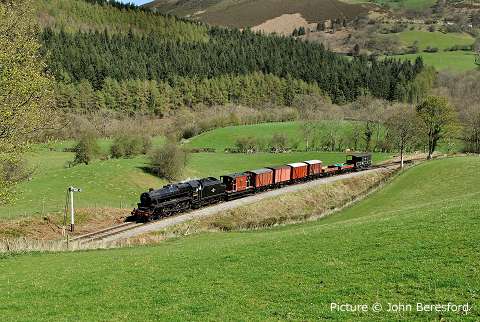
44806 with the demonstration freight passes Garth-y-Dwr on 8 April (John Beresford).
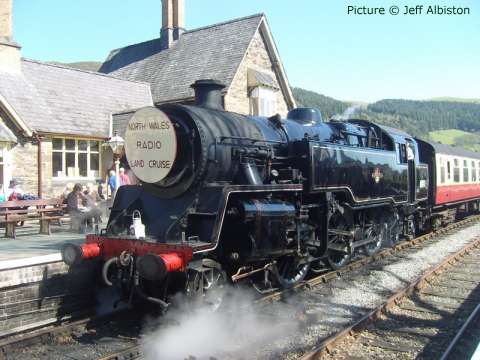

44806 with the demonstration freight passes Garth-y-Dwr on 8 April (John Beresford).

A memory of those 1950s summers: BR
Standard 4MT Tank 80072 at
Carrog on 8 April. The loco ran with a replica 'North Wales Radio
Land Cruise' headboard through the event. The headboard was constructed
by Llangollen fireman, Iain Ross (Jeff
Albiston).
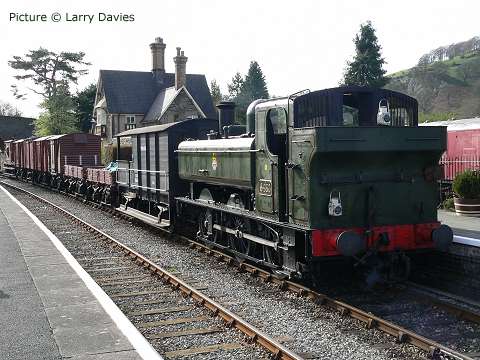
Memories of the pick up goods - a Pannier and half a dozen wagons, with 6430 in charge on 9 April (Larry Davies).
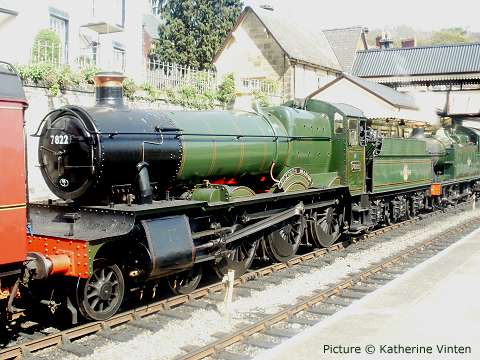
Foxcote Manor arrived at Llangollen on 10 April (Katherine Vinten)...
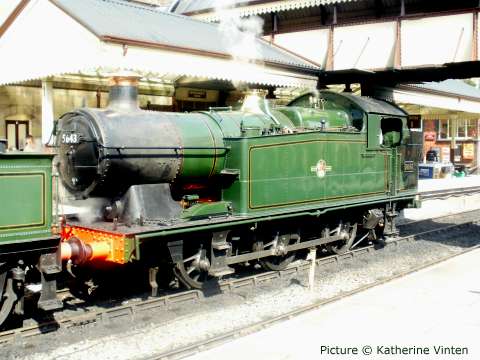
... piloted by 0-6-2T 5643 (Katherine Vinten).
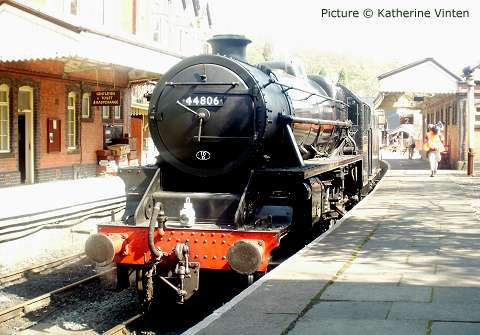
44806 stands at Llangollen (Katherine Vinten)
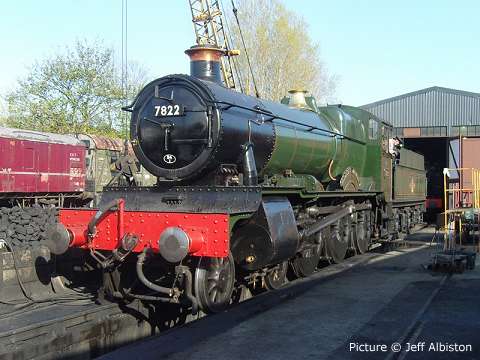
After completing three days' service, Foxcote Manor rests at Llangollen shed on 10 April. A huge credit goes to Dave Owen & his team for completing the loco in time for the event. The Manor now takes a break from duties and will next be in action over the Easter period (Jeff Albiston).
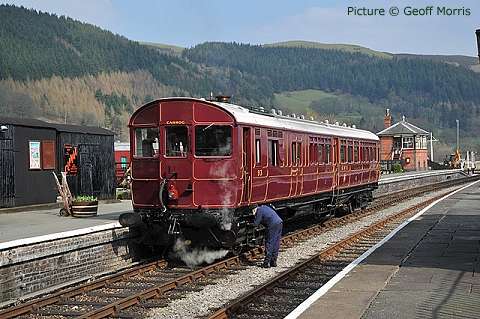
I was lucky enough to take part in a photo charter with the newly restored GWR Railmotor (no 93) on Wednesday 23 March. A few days later it was moved to The Didcot Railway Centre where it will remain for a couple of years.
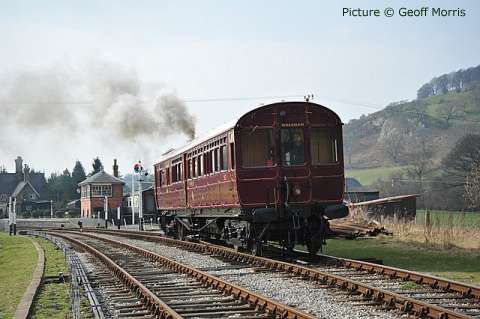
The vehicle ran with local destination boards (Wrexham & Carrog) at the appropriate ends, as can be seen in the two views above, taken at Carrog.
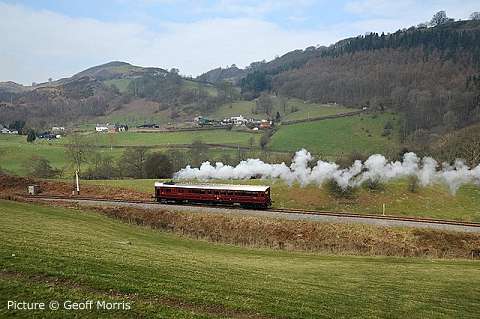
Above, a further view of it in action is shown at Garth-y-Dwr.
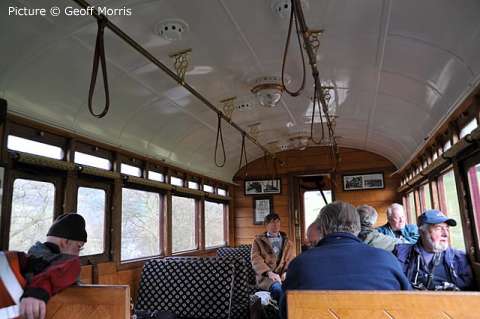
The interior of the vehicle has been finished to the same high standard as the exterior.
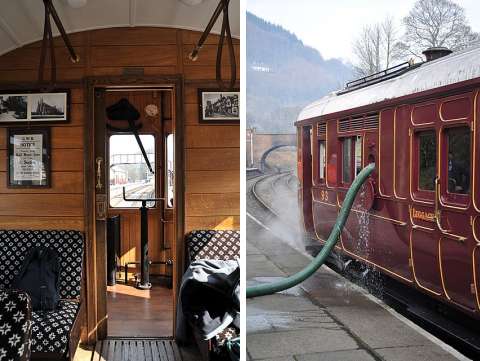
The water tank is slung underneath the vehicle but there holes through which water is taken about halfway up the body side on both sides of the vehicle. The holes are covered by flaps - not unlike the filler cap on a car (above, right).
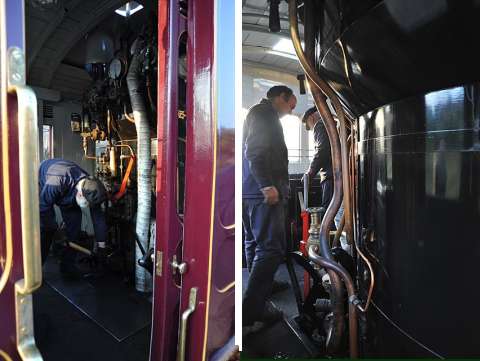
The boiler sits on its own power bogie, so firing is typically confined to when the vehicle is stationary - as the power bogie moves independently of the footplate. This makes it difficult to aim accurately - the position of the fire-hole when you start to swing the shovel will not necessarily be the same when you finish your swing!
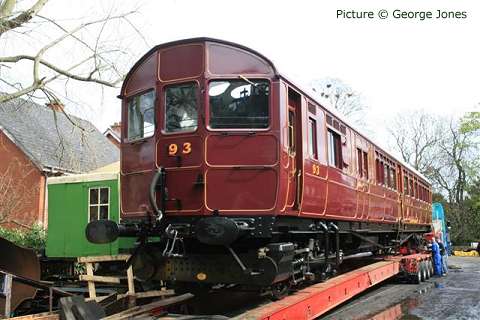
This picture by George Jones from 4 April shows no.93 being winched on to road transport for its journey to Didcot. No. 93 was built by the Great Western railway in 1908, an early attempt to reduce the costs of branch-line working; 99 examples were built. The vehicle weighs in at around 45 tons and has seating for 70 passengers with a crew of 3 – driver, fireman and guard. No.93 was based at Wrexham’s Croes Newydd shed in 1921/22 and this type of vehicle once operated on the line between Wrexham, Ruabon and Bala in the early part of the 20th century. The Great Western Society and its supporters raised £750,000 which has not only allowed the power bogie to be built but also included our contribution towards the restoration of the coach and matching trailer coach No. 92 which has been mainly funded by a Heritage Lottery Fund grant of £768,500.
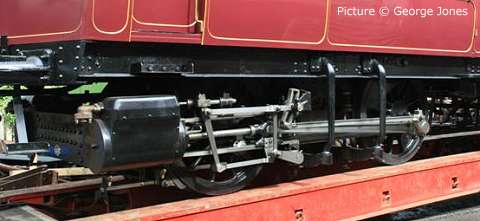
A close-up of the the steam power bogie, cylinders and motion - inside the body is a vertical boiler (George Jones).
The contract for the restoration work was awarded to the Llangollen Railway’s Engineering Department by the Great Western Society in 2008. The project as delivered to Llangollen provided a derelict wooden coach body which had survived in British Rail departmental use prior to acquisition and storage at the Didcot Railway Centre. The Llangollen Railway Carriage & Wagon Department converted it back to the Steam Railmotor configuration, rebuilding a large element of the original fabric, and installing appropriate features from the 1900s. Fortuitously, the traditional ‘walk-over’ seating was acquired from a scrapped tramcar in Australia.
The engine unit comprises a vertical boiler mounted on a four wheel bogie which components were made by sub-contractors and delivered to Llangollen for assembly. This involved the manufacture of the motion parts and fitting to create a steam-power unit. The only non-original aspect is the use of electric lighting in place of gas, although the battery installation has been cleverly disguised within the original gas canister which remains in place and traditional style gas lights feature electric bulbs.
The Steam Railmotor No.93 is due to be launched at a public occasion by the Great Western Society at Didcot on 28 May.
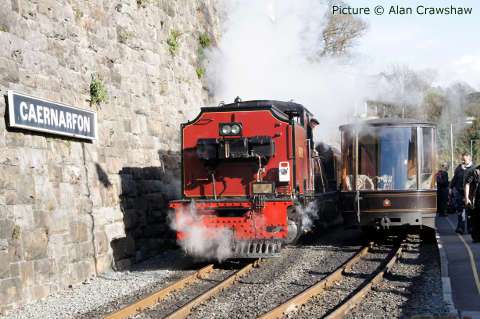
On 2 April Rowan and I undertook a circular tour from out home at Graianfryn Vegetarian Guest House, taking in the full length of the narrow gauge Ffestiniog and Welsh Highland Railways. Our timetable was as follows:
09:01 Padarn Bus 85
09:29 arr Bangor railway station
10:02 dep Bangor (Arriva Holyhead to Birmingham International service)
10:23 arr Llandudno Junction
10:34 dep Llandudno Jct (Arriva Conwy Valley line)
11:34 arr Blaenau Ffestiniog
11:50 dep Blaenau Ffestiniog (Ffestiniog)
13:00 arr Porthmadog
14:15 dep Porthmadog (Welsh Highland)
16:50 arr Caernarfon
17:10 Padarn bus 83 to take us home.
Planning a circular trip requires careful attention to the timetables as the FR/WHR pattern is variable and many of the Welsh Highland trains don’t run all the way because of capacity constraints at Porthmadog Harbour station. These times were valid only until 11 April (apart from Sunday, when there’s no Conwy Valley service), then for a period in October. Round trips are possible starting from Porthmadog at certain other times.
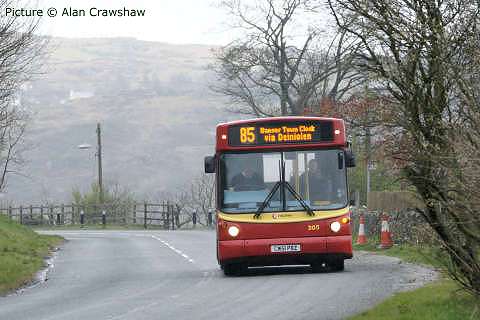
A short walk from home took us to the route of the Padarn service 85, the bus arrived punctually through the early gloom (above).
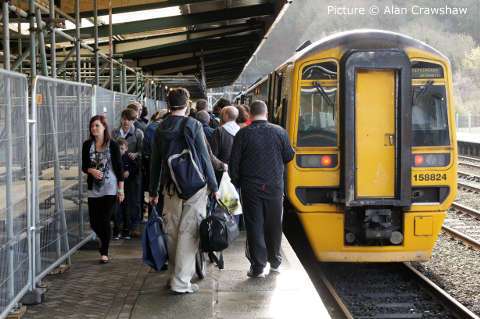
We alighted at Bangor station where we had half an hour to survey the extensive works being undertaken and during which the sky cleared. The sidings area is being prepared for a larger car park, paving slabs on platform 1 are being lifted and levelled with broken ones being replaced and the station building is sheathed with scaffolding. The picture above shows passengers squeezing on and off the 09:23 Holyhead to Birmingham International, the platform having been temporarily reduced in width by the works. 158 824 was very busy on leaving Bangor. A class 37/4 with four coaches would have coped better with a popular Saturday morning service but then we'd have had difficulty leaving it at Llandudno Junction for the Conwy Valley line.
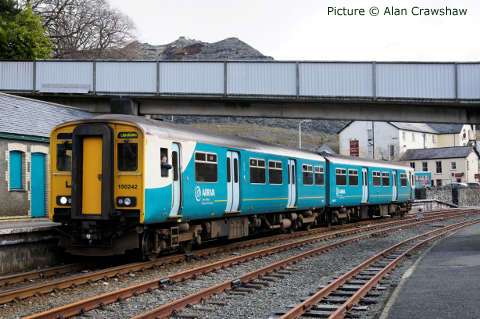
The 10:34 (seen above on arrival and Blaenau Ffestiniog) was also very busy: a couple of young mountain bikers who alighted at Llanrwst, a couple of road cyclists, but mainly older people taking advantage of free concessionary travel. The class 150 units aren't ideal for this route, many seats suffering from restricted views of the fine scenery.
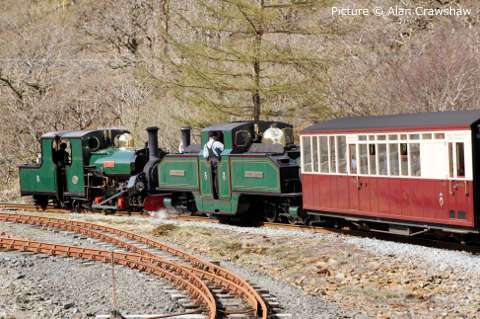
The incoming Ffestiniog service was delayed in arriving at Blaenau Ffestiniog because Blanche had failed with a blocked fuel pipe and was piloted by Earl of Merioneth so anyone hoping to connect with the Conwy Valley service would have been disappointed. A rapid run-round and a brisk return downhill saw us reach Porthmadog almost on time. Above is the view from the train as we rounded the sharp curve at Dduallt.
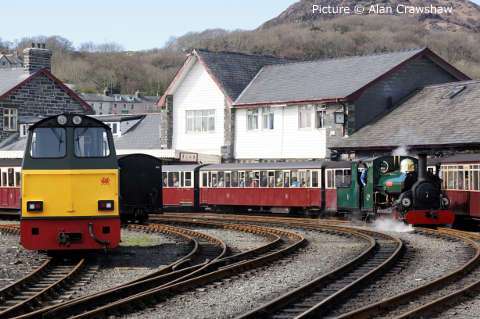
On arrival at Porthmadog, Blanche scuttled back to the depot at Boston Lodge while diesel Vale of Ffestiniog was on pilot duty for Welsh Highland trains.
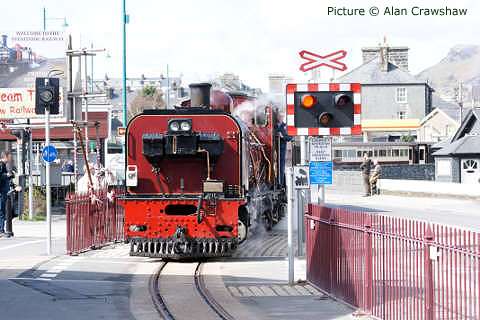
My leisurely pint of outstanding Holdens mild was interrupted by the siren announcing the arrival of a WHR train so I dashed out to grab a quick shot of Garratt 138 threading its way over the Britannia Bridge into Porthmadog Harbour station (above).
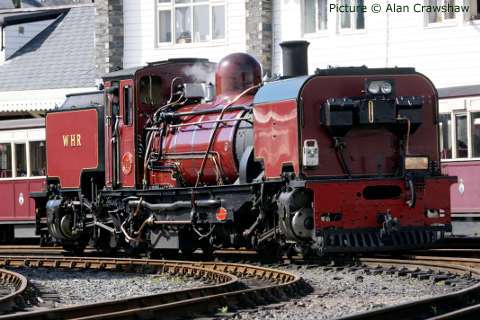
The Garratt was detached from the head of the train on the cob and Vale of Ffestiniog pulled the stock with passengers into Harbour station. 138 then ran through to be attached to the other end.
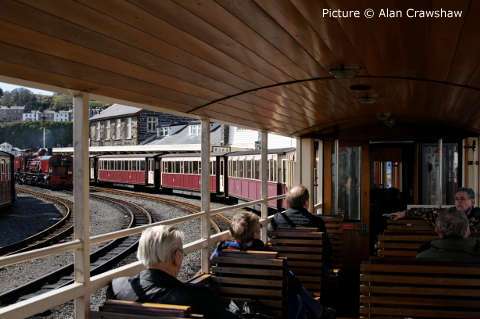
We took our seats in the open carriage at the rear and enjoyed our short diesel haulage before the mighty Garratt took us north.
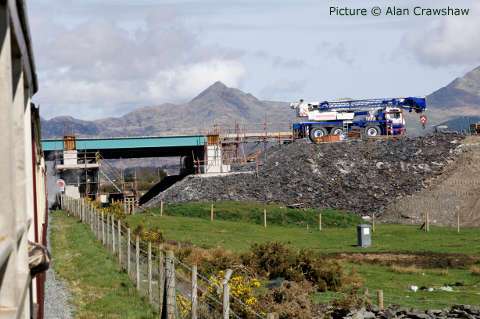
This was new track for us, over the Britannia Bridge and through the nether regions of town and passing beneath the Porthmadog by-pass under construction. The scenery at the southern end was more interesting than I expected, distant mountain views compensating for the flatness of the terrain. We were familiar with the line further north but the ride was no less enjoyable for that.
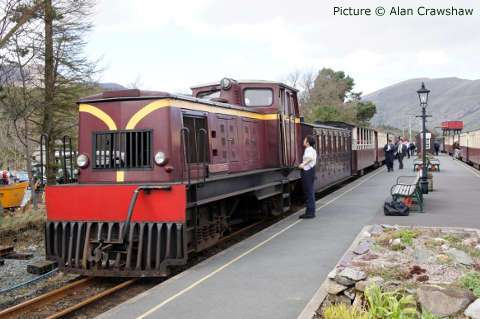
At the Rhyd Ddu water stop we crossed Castell Caernarfon on a southbound service (above).
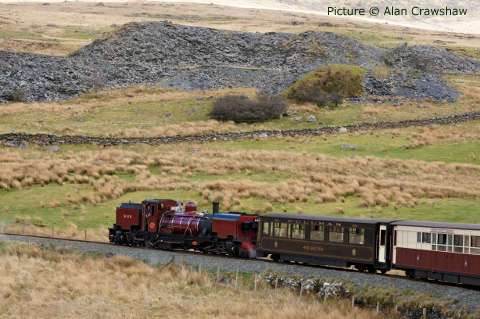
The sharp bends allow plenty of views of the locomotive.
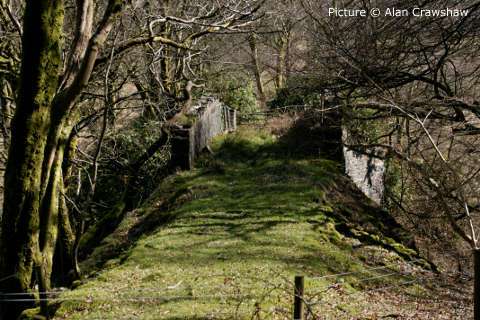
This picture shows the railway bridge by the Goat hotel in Beddgelert that never saw any track, being built for the abortive Portmadoc, Beddgelert & South Snowdon Railway.
We arrived punctually in Caernarfon (picture at the top of this article) and our day ended with a stroll to the bus station for Padarn service 83 which took us almost home. [In 2009 Llanberis-based Padarn Bus took over the KMP bus company of Llanberis which formerly operated the routes in this area.]
As reported here at the time, Network Rail closed the Cambrian Lines to passenger traffic for a week in late March, with very little notice given to the public, during the term time of the schools which depend on the route to bring their pupils. As can be imagined, this was not popular, as this Daily Post report from 7 March
ERTMS has, of course been in use for some time on some lines elsewhere in Europe, including high-speed routes.The original target for completion of this first British scheme was March 2009. Is the the 'contract' referred to is the maintenance contract for the old system? Apparently the next line to be converted may the the electrified 'Hertford Loop', part of the London Kings Cross suburban system.

Memories of the pick up goods - a Pannier and half a dozen wagons, with 6430 in charge on 9 April (Larry Davies).

Foxcote Manor arrived at Llangollen on 10 April (Katherine Vinten)...

... piloted by 0-6-2T 5643 (Katherine Vinten).

44806 stands at Llangollen (Katherine Vinten)

After completing three days' service, Foxcote Manor rests at Llangollen shed on 10 April. A huge credit goes to Dave Owen & his team for completing the loco in time for the event. The Manor now takes a break from duties and will next be in action over the Easter period (Jeff Albiston).
Railmotor restored - report by Geoff Morris
I was lucky enough to take part in a photo charter with the newly restored GWR Railmotor (no 93) on Wednesday 23 March. A few days later it was moved to The Didcot Railway Centre where it will remain for a couple of years.
The vehicle ran with local destination boards (Wrexham & Carrog) at the appropriate ends, as can be seen in the two views above, taken at Carrog.
Above, a further view of it in action is shown at Garth-y-Dwr.
The interior of the vehicle has been finished to the same high standard as the exterior.
The water tank is slung underneath the vehicle but there holes through which water is taken about halfway up the body side on both sides of the vehicle. The holes are covered by flaps - not unlike the filler cap on a car (above, right).
The boiler sits on its own power bogie, so firing is typically confined to when the vehicle is stationary - as the power bogie moves independently of the footplate. This makes it difficult to aim accurately - the position of the fire-hole when you start to swing the shovel will not necessarily be the same when you finish your swing!

This picture by George Jones from 4 April shows no.93 being winched on to road transport for its journey to Didcot. No. 93 was built by the Great Western railway in 1908, an early attempt to reduce the costs of branch-line working; 99 examples were built. The vehicle weighs in at around 45 tons and has seating for 70 passengers with a crew of 3 – driver, fireman and guard. No.93 was based at Wrexham’s Croes Newydd shed in 1921/22 and this type of vehicle once operated on the line between Wrexham, Ruabon and Bala in the early part of the 20th century. The Great Western Society and its supporters raised £750,000 which has not only allowed the power bogie to be built but also included our contribution towards the restoration of the coach and matching trailer coach No. 92 which has been mainly funded by a Heritage Lottery Fund grant of £768,500.

A close-up of the the steam power bogie, cylinders and motion - inside the body is a vertical boiler (George Jones).
The contract for the restoration work was awarded to the Llangollen Railway’s Engineering Department by the Great Western Society in 2008. The project as delivered to Llangollen provided a derelict wooden coach body which had survived in British Rail departmental use prior to acquisition and storage at the Didcot Railway Centre. The Llangollen Railway Carriage & Wagon Department converted it back to the Steam Railmotor configuration, rebuilding a large element of the original fabric, and installing appropriate features from the 1900s. Fortuitously, the traditional ‘walk-over’ seating was acquired from a scrapped tramcar in Australia.
The engine unit comprises a vertical boiler mounted on a four wheel bogie which components were made by sub-contractors and delivered to Llangollen for assembly. This involved the manufacture of the motion parts and fitting to create a steam-power unit. The only non-original aspect is the use of electric lighting in place of gas, although the battery installation has been cleverly disguised within the original gas canister which remains in place and traditional style gas lights feature electric bulbs.
The Steam Railmotor No.93 is due to be launched at a public occasion by the Great Western Society at Didcot on 28 May.
Narrow gauge circuit (assisted by Arriva and a bus) - report by Alan Crawshaw

On 2 April Rowan and I undertook a circular tour from out home at Graianfryn Vegetarian Guest House, taking in the full length of the narrow gauge Ffestiniog and Welsh Highland Railways. Our timetable was as follows:
09:01 Padarn Bus 85
09:29 arr Bangor railway station
10:02 dep Bangor (Arriva Holyhead to Birmingham International service)
10:23 arr Llandudno Junction
10:34 dep Llandudno Jct (Arriva Conwy Valley line)
11:34 arr Blaenau Ffestiniog
11:50 dep Blaenau Ffestiniog (Ffestiniog)
13:00 arr Porthmadog
14:15 dep Porthmadog (Welsh Highland)
16:50 arr Caernarfon
17:10 Padarn bus 83 to take us home.
Planning a circular trip requires careful attention to the timetables as the FR/WHR pattern is variable and many of the Welsh Highland trains don’t run all the way because of capacity constraints at Porthmadog Harbour station. These times were valid only until 11 April (apart from Sunday, when there’s no Conwy Valley service), then for a period in October. Round trips are possible starting from Porthmadog at certain other times.

A short walk from home took us to the route of the Padarn service 85, the bus arrived punctually through the early gloom (above).

We alighted at Bangor station where we had half an hour to survey the extensive works being undertaken and during which the sky cleared. The sidings area is being prepared for a larger car park, paving slabs on platform 1 are being lifted and levelled with broken ones being replaced and the station building is sheathed with scaffolding. The picture above shows passengers squeezing on and off the 09:23 Holyhead to Birmingham International, the platform having been temporarily reduced in width by the works. 158 824 was very busy on leaving Bangor. A class 37/4 with four coaches would have coped better with a popular Saturday morning service but then we'd have had difficulty leaving it at Llandudno Junction for the Conwy Valley line.

The 10:34 (seen above on arrival and Blaenau Ffestiniog) was also very busy: a couple of young mountain bikers who alighted at Llanrwst, a couple of road cyclists, but mainly older people taking advantage of free concessionary travel. The class 150 units aren't ideal for this route, many seats suffering from restricted views of the fine scenery.

The incoming Ffestiniog service was delayed in arriving at Blaenau Ffestiniog because Blanche had failed with a blocked fuel pipe and was piloted by Earl of Merioneth so anyone hoping to connect with the Conwy Valley service would have been disappointed. A rapid run-round and a brisk return downhill saw us reach Porthmadog almost on time. Above is the view from the train as we rounded the sharp curve at Dduallt.

On arrival at Porthmadog, Blanche scuttled back to the depot at Boston Lodge while diesel Vale of Ffestiniog was on pilot duty for Welsh Highland trains.

My leisurely pint of outstanding Holdens mild was interrupted by the siren announcing the arrival of a WHR train so I dashed out to grab a quick shot of Garratt 138 threading its way over the Britannia Bridge into Porthmadog Harbour station (above).

The Garratt was detached from the head of the train on the cob and Vale of Ffestiniog pulled the stock with passengers into Harbour station. 138 then ran through to be attached to the other end.

We took our seats in the open carriage at the rear and enjoyed our short diesel haulage before the mighty Garratt took us north.

This was new track for us, over the Britannia Bridge and through the nether regions of town and passing beneath the Porthmadog by-pass under construction. The scenery at the southern end was more interesting than I expected, distant mountain views compensating for the flatness of the terrain. We were familiar with the line further north but the ride was no less enjoyable for that.

At the Rhyd Ddu water stop we crossed Castell Caernarfon on a southbound service (above).

The sharp bends allow plenty of views of the locomotive.

This picture shows the railway bridge by the Goat hotel in Beddgelert that never saw any track, being built for the abortive Portmadoc, Beddgelert & South Snowdon Railway.
We arrived punctually in Caernarfon (picture at the top of this article) and our day ended with a stroll to the bus station for Padarn service 83 which took us almost home. [In 2009 Llanberis-based Padarn Bus took over the KMP bus company of Llanberis which formerly operated the routes in this area.]
Cambrian Closure causes Consternation
As reported here at the time, Network Rail closed the Cambrian Lines to passenger traffic for a week in late March, with very little notice given to the public, during the term time of the schools which depend on the route to bring their pupils. As can be imagined, this was not popular, as this Daily Post report from 7 March
Two schools are to get a cash
payout from train operators after pupils were left stranded by a line
closure. Arriva Trains Wales will pay Ysgol Ardudwy, Harlech, and Ysgol
Tywyn £1,000 each as an apology for closing the Cambrian Coast
Railway line for a week during term time.
A replacement bus service was organised, but some children travelling from Barmouth to Harlech were left without transport when the bus failed to turn up. There had been complaints that there was very little publicity over the closure and schools had to make alternative arrangements as their pupils shared lessons at other schools and used the train for transport.
Ysgol Ardudwy headmaster Tudur Williams said pupils’ education for the week was affected by the closure of the railway and he asked the rail authorities to keep to their agreement that work on the railway would be done outside school times.
Edward de Silva, head of the new ERTMS new signalling project on the Cambrian Line said there was no alternative to closing the line because extending the contract past the end of March would be very costly and Arriva Trains Wales had to comply with rail inspectors’ guidance.
Ben Davies, for Arriva Trains Wales said that his company had done their best to give prior publicity to the rail closure. 'We did contact the schools, Harlech and Tywyn were the schools affected most and as a gesture we are willing to contribute £1,000 to any schemes at both Tywyn and Harlech as a gesture,' said Mr Davies. He apologised for the bus not turning up in Barmouth and said: 'During that week we had to arrange 270 replacement buses along the whole of the Cambrian line.The bus company that failed to turn up to collect Barmouth school children had their contract withdrawn immediately. That’s how seriously we took the matter.'
Both Mr de Silva and Mr Davies said that the new multi million pound ERTMS signalling on the Cambrian line was now the most advanced signalling service in Europe.
A replacement bus service was organised, but some children travelling from Barmouth to Harlech were left without transport when the bus failed to turn up. There had been complaints that there was very little publicity over the closure and schools had to make alternative arrangements as their pupils shared lessons at other schools and used the train for transport.
Ysgol Ardudwy headmaster Tudur Williams said pupils’ education for the week was affected by the closure of the railway and he asked the rail authorities to keep to their agreement that work on the railway would be done outside school times.
Edward de Silva, head of the new ERTMS new signalling project on the Cambrian Line said there was no alternative to closing the line because extending the contract past the end of March would be very costly and Arriva Trains Wales had to comply with rail inspectors’ guidance.
Ben Davies, for Arriva Trains Wales said that his company had done their best to give prior publicity to the rail closure. 'We did contact the schools, Harlech and Tywyn were the schools affected most and as a gesture we are willing to contribute £1,000 to any schemes at both Tywyn and Harlech as a gesture,' said Mr Davies. He apologised for the bus not turning up in Barmouth and said: 'During that week we had to arrange 270 replacement buses along the whole of the Cambrian line.The bus company that failed to turn up to collect Barmouth school children had their contract withdrawn immediately. That’s how seriously we took the matter.'
Both Mr de Silva and Mr Davies said that the new multi million pound ERTMS signalling on the Cambrian line was now the most advanced signalling service in Europe.
ERTMS has, of course been in use for some time on some lines elsewhere in Europe, including high-speed routes.The original target for completion of this first British scheme was March 2009. Is the the 'contract' referred to is the maintenance contract for the old system? Apparently the next line to be converted may the the electrified 'Hertford Loop', part of the London Kings Cross suburban system.
North Wales Coast home page Archive Previous Noticeboard